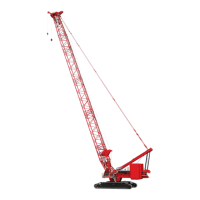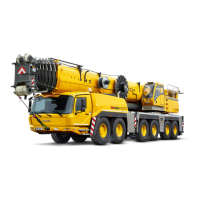ACCESSORIES MLC650 SERVICE/MAINTENANCE MANUAL
10-44
Published 09-09-16, Control # 229-09
VPC Counterweight Tray Motor Brakes
See Figure 10-34 for the following.
The VPC tray motor brakes are a spring-applied,
hydraulically released brake system. Each of the tray motors
(4 and 5) has an attached brake assembly (6) that is
disengaged when the control system energizes the brake
release solenoid valve (7). If the brake hydraulic pressure or
electrical control is lost, the brakes are applied by spring
force.
The tray motor brake release system uses hydraulic fluid
from the accessory pump 9 and charge pressure from pump
7 to release the brakes.
The brake release pressure must be at least 16 bar (232 psi)
to fully release the brakes. If the pressure is less than 16 bar
(232 psi), the brakes could remain partially applied, which
could damage the brake system.
To disengage the tray motor brakes, the IOLC31 control
module sends a 24 V
DC
output voltage to the brake release
solenoid valve, energizing the solenoid. The energized
solenoid valve routes hydraulic fluid to the brake piston on
each tray motor, releasing the brakes.
To engage the tray motor brakes, the IOLC31 control module
sends a 0 V
DC
output voltage to the brake release solenoid
valve, de-energizing the solenoid. The de-energized
solenoid causes the solenoid valve to return to the default
position, allowing the hydraulic fluid in the brake cylinders to
flow through the brake release solenoid valve, then back to
the tank. The reduced hydraulic pressure allows spring force
to apply the tray motor brakes.
